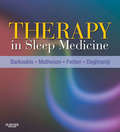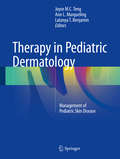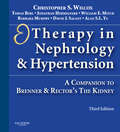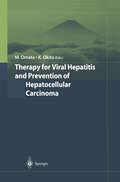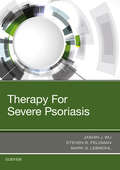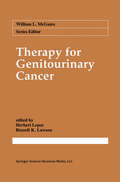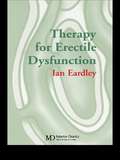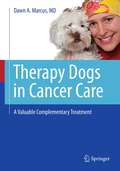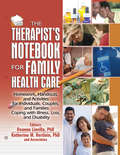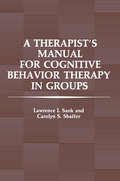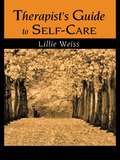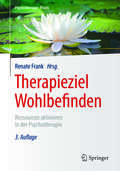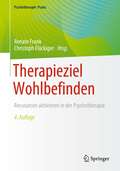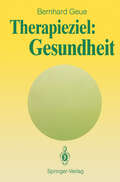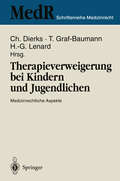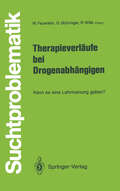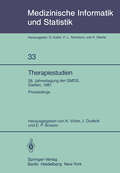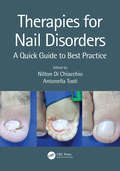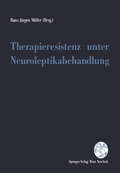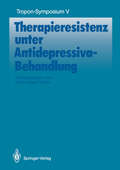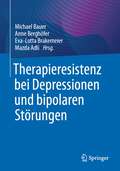- Table View
- List View
Therapy in Sleep Medicine E-Book: Expert Consult - Online And Print
by Teri J. Barkoukis Jean K. Matheson Richard Ferber Karl DoghramjiTherapy in Sleep Medicine, by Drs. Teri J. Barkoukis, Jean K. Matheson, Richard Ferber, and Karl Doghrami, provides the clinically focused coverage you need for rapid diagnosis and effective treatment of sleep disorders. A multidisciplinary team of leading authorities presents the latest on sleep breathing disorders (including obstructive sleep apnea), neuropharmacology, parasomnias, neurologic disorders affecting sleep, sleep therapy for women, sleep therapy in geriatric patients, controversies, and future trends in therapy in a highly illustrated, easy-to-follow format.Diagnose and treat patients effectively with complete coverage of the full range of sleep disorders. Find diagnostic and treatment information quickly and easily thanks to a highly illustrated, easy-to-read format that highlights key details. Stay current on discussions of hot topics, including sleep breathing disorders (including obstructive sleep apnea), neuropharmacology, parasomnias, neurologic disorders affecting sleep, sleep therapy for women, sleep therapy in geriatric patients, controversies, and future trends in therapy. Tap into the expertise of a multidisciplinary team of leading authorities for well-rounded, trusted guidance.
Therapy in Pediatric Dermatology: Management of Pediatric Skin Disease
by Joyce M.C. Teng Ann L. Marqueling Latanya T. BenjaminThis book addresses the need for comprehensive review of therapeutic options that are known to be efficacious in the management of cutaneous diseases in children. It summarizes evidence-based literature on clinical responses among pediatric patients, including age-appropriate management strategies. Included is review of the extraordinary developments in understanding of the genetics and pathogenesis of many cutaneous disorders during the past decade, the novel therapeutic options and repurposing of old drugs, and the management of some of the most challenging skin disorders.Therapy in Pediatric Dermatology: Management of Pediatric Skin Disease is a succinct, user-friendly, and up-to-date therapeutic dermatologic textbook for physicians who care for children with skin disorders. Each skin condition is discussed with investigative and treatment recommendations in mind and provided based on extensive review of the literature. This book will provide unbiased, yet concise, information that is valuable to practitioners who manage pediatric patients in their practices.
Therapy in Nephrology and Hypertension E-Book: A Companion to Brenner & Rector's The Kidney
by Christopher S. WilcoxThoroughly revised, the new edition of this companion to Brenner & Rector’s The Kidney equips you with today’s guidance to effectively manage renal and hypertension patients. International authorities emphasize the specifics of treatment while presenting field-tested advice on the best therapeutic strategies available. New chapters reflect the latest evidence impacting current clinical issues, while a new design helps you reference the information more easily.Presents the most comprehensive text available on nephrology and hypertension treatment for a convenient single source that is easy to consult. Features the evidence-based guidance of leading authorities for making more informed clinical decisions. Offers in-depth discussions and referenced coverage of key trials to help you analyze the results and the evidence provided. Provides treatment algorithms and tables of commonly used drugs in each chapter for quick-access expert advice on arriving at the best and most appropriate treatment regimen.Offers new chapters on erectile and sexual dysfunction, transplant immunology and immunosuppression, dietary salt restriction, and systematic vasculitis and pauci-immune glomerulonephritis that reflect new evidence impacting current clinical issues. Presents the contributions of newly assigned section editors—authorities in their subspecialty fields—who offer you the benefit of their practice-proven expertise. Provides rationales for the therapies presented to help you choose the most effective treatment for each patient.
Therapy for Viral Hepatitis and Prevention of Hepatocellular Carcinoma
by M. Omata, K. OkitaThe liver has an important role in nutritional homeostasis, and it is well known that liver diseases can lead to abnormalities in the nutrient metabolism and to subsequent malnutrition. Because malnutrition is particularly prevalent in patients with liver cirrhosis, proper nutritional assessment and support for cirrhotic patients is essential. This collection of research and clinical findings on nonalcoholic steatohepatitis (NASH) and nutritional therapy contains significant new findings in several fields. As NASH frequently causes liver cirrhosis, the nutritional aspects of its treatment are discussed. Other areas covered include nonalcoholic fatty liver, the role of leptin in the pathogenesis of NASH, restricted diets and exercise therapy, mammalian targets of the peptide rapamycin, and genetic factors influencing the development of NASH. This book is intended to be of particular relevance to researchers and those practicing in the field.
Therapy for Severe Psoriasis E-Book: Expert Consult
by Jashin J. Wu Steven R. Feldman Mark G. LebwohlA brand-new title in the field of dermatology, Therapy for Severe Psoriasis provides the ultimate coverage of the treatment options available for today's most serious cases, including biologics and oral therapies. It features discussions of the newest drug therapies, recent FDA-approved biosimilars, and combination approaches to care, while an overview chapter was designed to aid those new to the field in understanding the nuances of difficult-to-treat subtypes of psoriasis. Comprehensive and focused, Therapy for Severe Psoriasis will be a welcome addition to the library of any dermatologist seeking in-depth information on the challenges of this condition.Each of the 16 chapters includes either an in-depth focus on a single therapy or an overview of a unique aspect of psoriasis, including: UVB therapy, methotrexate, acitretin, cyclosporine, apremilast, etanercept, infliximab, adalimumab, ustekinumab, secukinumab, and ixekizumab.Takes an evidence-based approach to hard-to-treat severe psoriasis.Discusses the newest drug therapies (such as ixekizumab), plus recent FDA-approved biosimilars, a topic unique to this particular psoriasis text.Presents combination approaches for instances when standard treatments are not successful.Includes an overview chapter to help beginners understand the nuances of the disorder.
Therapy for Genitourinary Cancer (Cancer Treatment and Research #59)
by Russell K. Lawson HerbertLeporWhere do you begin to look for a recent, authoritative article on the diag nosis or management of a particular malignancy? The few general oncology textbooks are generally out of date. Single papers in specialized journals are informative but seldom comprehensive; these are more often preliminary reports on a very limited number of patients. Certain general journals frequently publish good in-depth reviews of cancer topics, and published symposium lectures are often the best overviews available. Unfortunately, these reviews and supplements appear sporadically, and the reader can never be sure when a topic of special interest will be covered. Cancer Treatment and Research is a series of authoritative volumes that aim to meet this need. It is an attempt to establish a critical mass of oncology literature covering virtually all oncology topics, revised frequently to keep the coverage up to date, and easily available on a single library shelf or by a single personal subscription. We have approached the problem in the following fashion: first, by dividing the oncology literature into specific subdivisions, such as lung cancer, genitourinary cancer, pediatric oncology, etc.; and second, by asking eminent authorities in each of these areas to edit a volume on the specific topic on an annual or biannual basis. Each topic and tumor type is covered in a volume appearing frequently and predictably, discussing current diag nosis, staging, markers, all forms of treatment modalities, basic biology, and more.
Therapy for Erectile Dysfunction: Pocketbook
by Ian EardleyErectile dysfunction is a common problem that may result from a number of medical conditions. With increasing public awareness, men with ED are seeking medical help. This pocketbook will assist the physician in treating and managing ED effectively with either drugs or devices.
Therapy for Erectile Dysfunction: Pocketbook
by Ian EardleyErectile dysfunction is a common problem that may result from a number of medical conditions. With increasing public awareness, men with ED are seeking medical help. This pocketbook will assist the physician in treating and managing ED effectively with either drugs or devices.
Therapy Dogs in Cancer Care: A Valuable Complementary Treatment
by Dawn A. MarcusDogs that visit patients with cancer have been convincingly shown to reduce stress, loneliness, and mood disturbance that may complicate cancer care. In addition, dogs may provide important motivation for patients to maintain rehabilitation programs that have been shown to reduce cancer risk and improve cancer survival. Outlining all of these issues and many more, Therapy Dogs in Cancer Care: A Valuable Complementary Treatment is a ground-breaking, highly innovative addition to the literature on cancer care. Detailing a comprehensive summary of truly impressive research demonstrating the ability of dogs to serve an important therapeutic role within the cancer arena and in other serious medical conditions, the text provides highly practical advice and very helpful “tips” to ensure that those who wish to employ dogs to assist the cancer patient have the necessary knowledge and “tools” to optimize outcomes. Authored by Dawn A. Marcus, MD, an expert in both pain management and health improvement through human and dog interaction, Therapy Dogs in Cancer Care: A Valuable Complementary Treatment is an extremely well-organized, well-researched, and highly readable book. Providing practical suggestions to effectively incorporate dogs into cancer care, with detailed instructions about requirements for therapy dogs to ensure visits are safe and limit unwanted spread of infection, Therapy Dogs in Cancer Care: A Valuable Complementary Treatment is an invaluable reference that will inform and delight both the clinician desiring a “how-to” text as well as the casual reader.
The Therapist's Notebook for Family Health Care: Homework, Handouts, and Activities for Individuals, Couples, and Families Coping with Illness, Loss, and Disability
by Deanna Linville Katherine M. HertleinEffective interventions to help your clients deal with illness, disability, grief, and loss The Therapist’s Notebook for Family Health Care presents creative interventions for working with individuals, couples, and families dealing with illness, loss, and disability. This book offers creative resources like homework, handouts, and activities, and effective, field-tested interventions to provide counselors with useful information on specific family dynamics and topics. It equips mental health clinicians with practical therapeutic activities to use in their work with clients struggling with health care or grief issues. The effects of illness, disability, and loss in everyday life can be profound. Besides the individual repercussions, these challenges also affect the lives of the family and social networks of those individuals experiencing them. The Therapist’s Notebook for Family Health Care brings together the knowledge and experience of over 30 experts in the field for a unique collection that therapists and clients alike will find immediately useful. Situated in four unique subject-specific sections for quick reference, this text covers a broad scope of common problems. Also included is a bonus section focusing on thoughtful suggestions for self-care and professional development. Some of the many topics and techniques presented in The Therapist’s Notebook for Family Health Care include: conducting interviews using the biopsychosocial-spiritual method using the Family System Test (FAST) to explore clients’ experiences with their healthcare system and providers increasing social support to manage chronic illness coping and adapting to developmental changes, challenges, and opportunities using a patient education tool in family therapy helping children (and their families) to manage pain through knowledge and diaphragmatic breathing creating a personal “superhero” for a child as a means to empowerment and relief of anxiety facilitating family problems using scatterplots building functional perspective of self and others in clients with Asperger Syndrome quilting as a meaning-making intervention for HIV/AIDS empowering terminally-ill patients to say goodbye to their young children in meaningful ways and many more!With a wealth of tables, charts, handouts, and bibliotherapy resources for clients; readings and resources for clinicians; and case vignettes, The Therapist’s Notebook for Family Health Care is an excellent resource for a wide variety of practitioners, including, counselors, psychologists, social workers, grief workers, hospice workers, health psychologists, and medical social workers. It is also an ideal text for psychotherapy and counseling students and educators.
The Therapist's Notebook for Family Health Care: Homework, Handouts, and Activities for Individuals, Couples, and Families Coping with Illness, Loss, and Disability
by Deanna Linville Katherine M. HertleinEffective interventions to help your clients deal with illness, disability, grief, and loss The Therapist’s Notebook for Family Health Care presents creative interventions for working with individuals, couples, and families dealing with illness, loss, and disability. This book offers creative resources like homework, handouts, and activities, and effective, field-tested interventions to provide counselors with useful information on specific family dynamics and topics. It equips mental health clinicians with practical therapeutic activities to use in their work with clients struggling with health care or grief issues. The effects of illness, disability, and loss in everyday life can be profound. Besides the individual repercussions, these challenges also affect the lives of the family and social networks of those individuals experiencing them. The Therapist’s Notebook for Family Health Care brings together the knowledge and experience of over 30 experts in the field for a unique collection that therapists and clients alike will find immediately useful. Situated in four unique subject-specific sections for quick reference, this text covers a broad scope of common problems. Also included is a bonus section focusing on thoughtful suggestions for self-care and professional development. Some of the many topics and techniques presented in The Therapist’s Notebook for Family Health Care include: conducting interviews using the biopsychosocial-spiritual method using the Family System Test (FAST) to explore clients’ experiences with their healthcare system and providers increasing social support to manage chronic illness coping and adapting to developmental changes, challenges, and opportunities using a patient education tool in family therapy helping children (and their families) to manage pain through knowledge and diaphragmatic breathing creating a personal “superhero” for a child as a means to empowerment and relief of anxiety facilitating family problems using scatterplots building functional perspective of self and others in clients with Asperger Syndrome quilting as a meaning-making intervention for HIV/AIDS empowering terminally-ill patients to say goodbye to their young children in meaningful ways and many more!With a wealth of tables, charts, handouts, and bibliotherapy resources for clients; readings and resources for clinicians; and case vignettes, The Therapist’s Notebook for Family Health Care is an excellent resource for a wide variety of practitioners, including, counselors, psychologists, social workers, grief workers, hospice workers, health psychologists, and medical social workers. It is also an ideal text for psychotherapy and counseling students and educators.
A Therapist’s Manual for Cognitive Behavior Therapy in Groups
by L.I. Sank C.S. ShafferOne of the great advantages of rational-emotive therapy (RET) and cog nitive behavior therapy (CBT) is that they frequently employ psycho educational methods-including bibliotherapy, workshops, lectures, courses, recordings, and films. I created RET at the beginning of 1955 after I had abandoned the practice of psychoanalysis because I found it to be highly inefficient and philosophically superficial. Being almost addicted to one-to-one therapy as a result of my analytic training and experience, I at first did RET only with individual clients and found this pioneering form of CBT considerably more effective than the other ther apies with which I had experimented. By 1957, however, I realized that RET could be taught to large num bers of persons through self-help books and articles and that RET -ori ented writings could not only prove valuable to the general public but that they could also be successfully employed to hasten and intensify the therapy of my individual clients. I therefore wrote a number of RET self help books-especially How to Live with a Neurotic (1957), Sex without Guilt (1958), A New Guide to Rational Living (with Robert A. Harper; original edition, 1961), and A Guide to Successful Marriage (with Robert A. Harper, 1961).
Therapist's Guide To Self-care (PDF)
by Lillie WeissPsychotherapy is an increasingly stressful profession. Yet therapists spend most of their time helping clients deal with their stress, not caring for their own. This book is designed as a tool for the experienced counselor, junior therapist, and graduate student, as the issues confronted and discussed herein are relevant to anyone in the field, regardless of experience or expertise. Dr. Weiss has written a book in an easy, conversational tone, filled with concrete examples and blending research findings, clinical experience and theoretical approaches into practical suggestions and sound advice. The book is divided into three parts, discussing therapist concerns and questions that are continually raised, and providing practical tools based on clinical experience and research findings. It will be useful to all mental health professionals who have felt the strain of their practice.
Therapist's Guide To Self-care
by Lillie WeissPsychotherapy is an increasingly stressful profession. Yet therapists spend most of their time helping clients deal with their stress, not caring for their own. This book is designed as a tool for the experienced counselor, junior therapist, and graduate student, as the issues confronted and discussed herein are relevant to anyone in the field, regardless of experience or expertise. Dr. Weiss has written a book in an easy, conversational tone, filled with concrete examples and blending research findings, clinical experience and theoretical approaches into practical suggestions and sound advice. The book is divided into three parts, discussing therapist concerns and questions that are continually raised, and providing practical tools based on clinical experience and research findings. It will be useful to all mental health professionals who have felt the strain of their practice.
Therapieziel Wohlbefinden: Ressourcen aktivieren in der Psychotherapie (Psychotherapie: Praxis)
by Renate FrankDieses Buch stellt Psychotherapieansätze vor, die sich spezifisch auf Wohlbefinden, menschliche Stärken und seelische Gesundheit konzentrieren, u. a. ressourcenorientierte Psychotherapie, euthyme Therapie, Well-Being-Therapie, Mindfulness Based Therapy sowie narrative und Sinn fördernde Ansätze. Positive Psychologie und Wohlbefindensforschung finden immer mehr Beachtung: Was sind die Auswirkungen von Wohlbefinden, positiven Gefühlen, Zufriedenheit, konstruktiven Gedanken und eigenen Stärken? Wie begünstigen diese auch angesichts von Stress und Lebensbeeinträchtigungen ein erfülltes, produktives Leben? Und: Wie lässt sich Wohlbefinden im Rahmen einer Psychotherapie ganz direkt fördern? Geschrieben für Psychologische und Ärztliche Psychotherapeuten, Kinder- und Jugendlichenpsychotherapeuten, Psychiater, Klinische Psychologen.
Therapieziel Wohlbefinden: Ressourcen aktivieren in der Psychotherapie (Psychotherapie: Praxis)
by Renate Frank Christoph FlückigerDieses Buch stellt Psychotherapieansätze vor, die sich spezifisch auf Wohlbefinden, menschliche Stärken und seelische Gesundheit konzentrieren, u. a. ressourcenorientierte Psychotherapie, euthyme Therapie, Well-Being-Therapie, Mindfulness Based Therapy sowie narrative und Sinn fördernde Ansätze. Positive Psychologie und Wohlbefindensforschung finden immer mehr Beachtung: Was sind die Auswirkungen von Wohlbefinden, positiven Gefühlen, Zufriedenheit, konstruktiven Gedanken und eigenen Stärken? Wie begünstigen diese auch angesichts von Stress und Lebensbeeinträchtigungen ein erfülltes, produktives Leben? Und: Wie lässt sich Wohlbefinden im Rahmen einer Psychotherapie ganz direkt fördern? Geschrieben für ... Psychologische und Ärztliche Psychotherapeuten, Kinder- und Jugendlichenpsychotherapeuten, Psychiater, Klinische Psychologen. Über die Herausgeber:innen: Dr. Renate Frank, promovierte Psychologin und Psychotherapeutin. Sie leitete die verhaltenstherapeutische Ambulanz der Universität Gießen; ihre Arbeits- und Forschungsschwerpunkte: Wohlbefinden und Lebensqualität. Prof. Dr. phil. Christoph Flückiger, Psychotherapeut und Supervisor, Leiter der Spezialpraxis für Generalisierte Angststörungen Universität Zürich; seine Forschungs- und Lehrinteressen: Erforschung allgemeiner Wirkfaktoren in der Psychotherapie und in psychologischen Interventionen.
Therapieverweigerung bei Kindern und Jugendlichen: Medizinrechtliche Aspekte 6. Einbecker Workshop der Deutschen Gesellschaft für Medizinrecht in Zusammenarbeit mit der Deutschen Gesellschaft für Kinderheilkunde 24. – 26. März 1995 (MedR Schriftenreihe Medizinrecht)
by Christian Dierks Toni Graf-Baumann Hans-Gerd LenardDer Dissens zwischen elterlichem und ärztlichem Willen bei der Behandlung von Kindern und Jugendlichen beschäftigt seit Jahren die Gerichtsbarkeit. Aus neuerer Zeit stammen in Deutschland Entscheidungen zum Konflikt des Schwangerschaftsabbruchs bei Minderjährigen, Empfängnisverhütung von Minderjährigen, Sterilisation und Operationen am geistig Behinderten. In einem gemeinsamen Workshop der Deutschen Gesellschaft für Kinderheilkunde und der Deutschen Gesellschaft für Medizinrecht wurden auf der Basis von Analysen problematischer Kasuistiken Empfehlungen zu den Fragen der Therapieverweigerung bei Kindern und Jugendlichen erarbeitet, die den betroffenen Ärzten und Juristen eine konstruktive Diskussion in diesem komplexen Problemkreis ermöglichen und patientengerechte Entscheidungen erleichtern sollen.
Therapieverläufe bei Drogenabhängigen: Kann es eine Lehrmeinung geben? (Suchtproblematik)
by Wilhelm Feuerlein Gerhard Bühringer Rolf WilleDas Buch enthält die Vorträge des 7. Wissenschaftlichen Symposiums der Deutschen Hauptstelle gegen die Suchtgefahren. Erstes Ziel dieser Tagung war eine Bestandsaufnahme über Studien zu Verlauf und Ergebnissen der Therapie von Drogenabhängigkeit im internationalen Vergleich. Durch das zweite Ziel der Tagung, nämlich die Ableitung einer Lehrmeinung aus den vorliegenden Forschungsergebnissen im Sinne praxisrelevanter Regeln für die Therapie, wurde erstmals eine Diskussion begonnen, die in Zukunft fortgeführt werden muß. Aktuelle Themen wie die HIV-Infektion sowie Vor- und Nachteile der Methadontherapie werden ausführlich diskutiert. Ein aktueller Leitfaden über den gegenwärtigen Stand der Drogentherapie und ihre Ergebnisse.
Therapiestudien: 26. Jahrestagung der GMDS, 21. – 23. September 1981, Gießen. Proceedings (Medizinische Informatik, Biometrie und Epidemiologie #33)
by N. Victor J. Dudeck E. P. BroszioTherapies for Nail Disorders: A Quick Guide to Best Practice
by Antonella Tosti Nilton Di ChiacchioThis concise text presents the essential points of diagnosis and a quick guide to what are currently the best evidence-based practices in treatment methods. In addition to material on the diseases themselves, there are useful appendices on how to carry out ancillary procedures. Contents: Acute paronychia * Bowen disease * Brittle nails * Chronic paronychia * Eczema * Erythronychia * Glomus tumor * Hematomas * Herpes simplex * Ingrowing nail * Lichen planus * Melanoma * Melanonychias * Myxoid cysts * Onycholysis * Onychomatricoma * Onychomycosis * Onychotillomania * Psoriasis * Retronychia * Squamous cell carcinoma * Subungual exostosis * Trachyonychia * Transverse overcurvature * Warts * Yellow nail syndrome * Practical procedures * Preparing a biopsy specimen
Therapies for Nail Disorders: A Quick Guide to Best Practice
by Antonella Tosti Nilton Di ChiacchioThis concise text presents the essential points of diagnosis and a quick guide to what are currently the best evidence-based practices in treatment methods. In addition to material on the diseases themselves, there are useful appendices on how to carry out ancillary procedures. Contents: Acute paronychia * Bowen disease * Brittle nails * Chronic paronychia * Eczema * Erythronychia * Glomus tumor * Hematomas * Herpes simplex * Ingrowing nail * Lichen planus * Melanoma * Melanonychias * Myxoid cysts * Onycholysis * Onychomatricoma * Onychomycosis * Onychotillomania * Psoriasis * Retronychia * Squamous cell carcinoma * Subungual exostosis * Trachyonychia * Transverse overcurvature * Warts * Yellow nail syndrome * Practical procedures * Preparing a biopsy specimen
Therapieresistenz unter Neuroleptikabehandlung
by Hans-Jürgen MöllerIn der Behandlung schizophrener Patienten mit Neuroleptika kommt es in einem nicht unerheblichen Prozentsatz zu Therapieresistenz. Das Ausmaß dieser Problematik wird bereits aus den kontrollierten Therapiestudien zu den ersten Neuroleptika deutlich. Selbst unter den, im Vergleich zu kontrollierten Therapiestudien, weniger restriktiven Bedingungen der psychiatrischen Routineversorgung (Möglichkeit zu längerer Behandlung, zu höherer Dosierung, zu Präparatewechsel etc.) kommt es in einem noch immer erheblichen Prozentsatz, insbesondere bei den selektierten Patienten im stationären Bereich, zu einem unbefriedigenden Therapieerfolg. Im Rahmen eines Workshops, der anläßlich des Symposions der AGNP (Arbeitsgemeinschaft für Neuropsychopharmakologie und Pharmakopsychiatrie) im Herbst 1989 stattfand, stand diese Thematik im Zentrum. Hintergrundfaktoren und Behandlungsmöglichkeiten der Therapieresistenz von Neuroleptika wurden von verschiedenen Experten dargestellt und diskutiert. Die überarbeiteten und aktualisierten Beiträge dieses Symposions wurden in dem hier vorliegenden Band publiziert, um allen wissenschaftlich oder praktisch an dieser Thematik interessierten Kollegen den "state of the art" nahezubringen.
Therapieresistenz unter Antidepressiva-Behandlung (Bayer-ZNS-Symposium #5)
by Hans-Jürgen MöllerAntidepressiva-Therapieresistenz ist einer der häufigsten Einweisungsgründe ambulant behandelter depressiver Patienten zur stationären Behandlung. Sie stellt ein relevantes Problem dar. Das Buch beschäftigt sich mit Erklärungsansätzen hierfür, weist auf die Behandlungprobleme hin und zeigt therapeutische Möglichkeiten auf, die für den in der klinischen Praxis tätigen Psychiater von großer Relevanz sind.
Therapieresistenz bei Depressionen und bipolaren Störungen
by Michael Bauer Anne Berghöfer Eva-Lotta Brakemeier Mazda AdliTherapieresistente depressive und bipolare Störungen stellen ungebrochen eine klinische Herausforderung dar: Therapeutisches Nichtansprechen bzw. Therapieresistenz depressiver und bipolarer Erkrankungen sind nicht nur häufig, sie erfordern oft auch eine stationäre Behandlung. Für Betroffene und Angehörige bedeutet das erhebliche Einschränkungen der Lebensqualität und der sozialen und beruflichen Funktionsfähigkeit. Therapieresistente Verläufe verursachen gleichzeitig sehr hohe Behandlungskosten.Um dieser Herausforderung zu begegnen, steht heute ein breites Spektrum pharmakologischer, psychotherapeutischer und psychosozialer Behandlungsmöglichkeiten zur Verfügung, das spezielle Kenntnisse und Erfahrungen voraussetzt. In diesem Buch stellen daher namhafte ExpertInnen in kurzen, prägnanten Kapiteln wissenschaftlich fundiert und mit hohem Praxisbezug den aktuellen Wissensstand dar und bieten Leitlinien für die Behandlung in Klinik und Praxis.Dabei werden auch neue Methoden, wie weiterentwickelte Hirnstimulationsverfahren, Chancen und Grenzen pharmakogenetischer Methoden zur präziseren Therapieempfehlung („bedside genotyping“), neue psychotherapeutische und pharmakologische Ansätze sowie innovative integrierte Versorgungsformen berücksichtigt. Das Buch richtet sich an PsychiaterInnen, NervenärztInnen, PsychotherapeutInnen und PsychologInnen, insbesondere im stationären Setting, aber auch in spezialisierten Praxen, sowie WissenschaftlerInnen von Forschungseinrichtungen und Industrieunternehmen.
